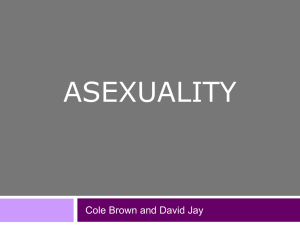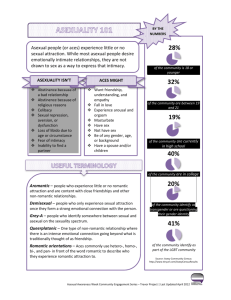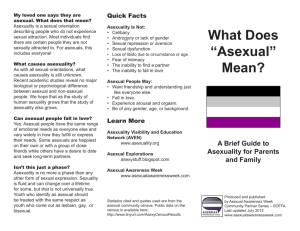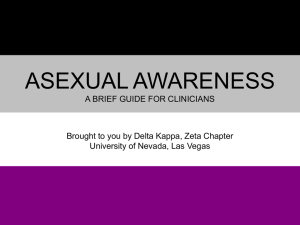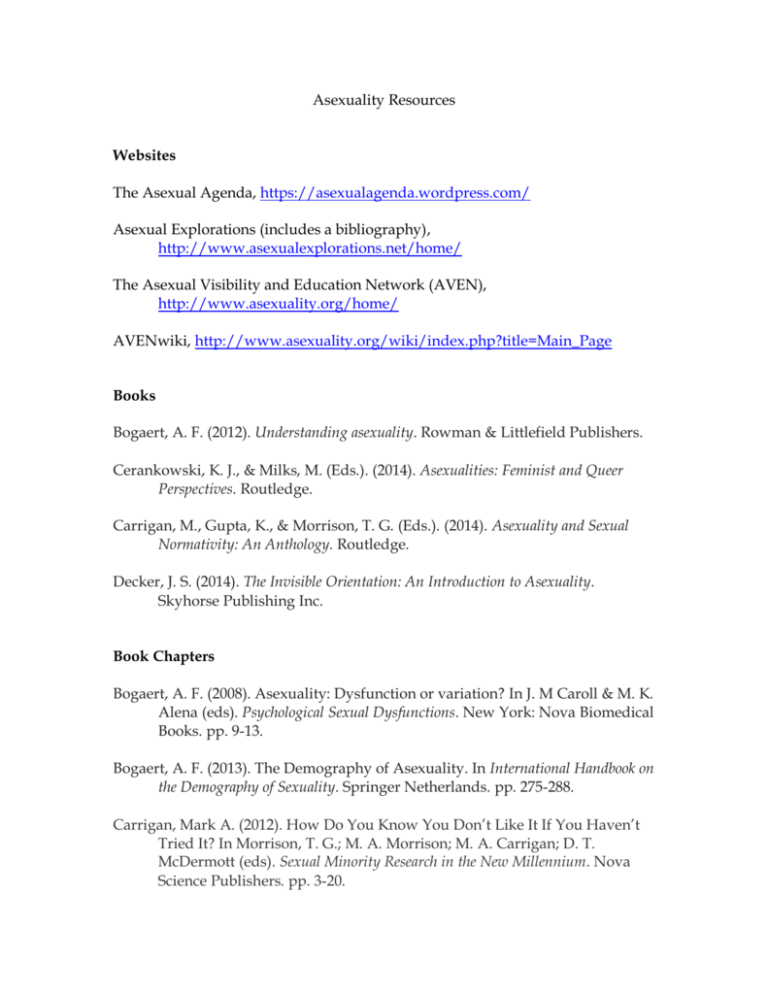
Asexuality Resources
Websites
The Asexual Agenda, https://asexualagenda.wordpress.com/
Asexual Explorations (includes a bibliography),
http://www.asexualexplorations.net/home/
The Asexual Visibility and Education Network (AVEN),
http://www.asexuality.org/home/
AVENwiki, http://www.asexuality.org/wiki/index.php?title=Main_Page
Books
Bogaert, A. F. (2012). Understanding asexuality. Rowman & Littlefield Publishers.
Cerankowski, K. J., & Milks, M. (Eds.). (2014). Asexualities: Feminist and Queer
Perspectives. Routledge.
Carrigan, M., Gupta, K., & Morrison, T. G. (Eds.). (2014). Asexuality and Sexual
Normativity: An Anthology. Routledge.
Decker, J. S. (2014). The Invisible Orientation: An Introduction to Asexuality.
Skyhorse Publishing Inc.
Book Chapters
Bogaert, A. F. (2008). Asexuality: Dysfunction or variation? In J. M Caroll & M. K.
Alena (eds). Psychological Sexual Dysfunctions. New York: Nova Biomedical
Books. pp. 9-13.
Bogaert, A. F. (2013). The Demography of Asexuality. In International Handbook on
the Demography of Sexuality. Springer Netherlands. pp. 275-288.
Carrigan, Mark A. (2012). How Do You Know You Don’t Like It If You Haven’t
Tried It? In Morrison, T. G.; M. A. Morrison; M. A. Carrigan; D. T.
McDermott (eds). Sexual Minority Research in the New Millennium. Nova
Science Publishers. pp. 3-20.
Gazzola, S. B. & M. A. Morrison. (2012). Asexuality: An Emergent Sexual
Orientation. In Morrison, T. G.; M. A. Morrison; M. A. Carrigan; D. T.
McDermott (eds). Sexual Minority Research in the New Millennium. Nova
Science Publishers. pp. 21-44.
Johnson, M. T. (1977). Asexual and Autoerotic Women: Two invisible groups. In
ed. Gorchros H.L. and Gochros J.S. The Sexually Oppressed. New York:
Associated Press
Kim, EJ. (2010). How much sex is healthy? The pleasures of asexuality. In J. M.
Metzl and A. Kirkland (eds). Against Health: How Health Became the New
Morality. New York: New York University Press. pp. 157-169.
Scherrer, K. (2010). Asexual Relationships: What does asexuality have to do with
polyamory? In M. Barker and D. Langdridge (eds.) Understanding NonMonogamies. Routledge. pp. 154-159.
Articles
Aicken, C. R., Mercer, C. H., & Cassell, J. A. (2013). Who reports absence of
sexual attraction in Britain? Evidence from national probability surveys.
Psychology & Sexuality, 4(2), 121-135.
Bishop, C. J. (2013). A mystery wrapped in an enigma–asexuality: a virtual
discussion. Psychology & Sexuality, 4(2), 195-206.
Bogaert, A. F. (2012). Asexuality and autochorissexualism (identity-less
sexuality). Archives of sexual behavior, 41(6), 1513-1514.
Bogaert, A. F. (2004). Asexuality: Prevalence and associated factors in a national
probability sample. Journal of Sex Research, 41(3), 279-287.
Bogaert, A. F. (2006). Toward a conceptual understanding of asexuality. Review of
General Psychology, 10(3), 241.
Brotto, Lori et al. “Asexuality: A Mixed-Methods Approach.” Archives of Sexual
Behavior 39 (2010): 599-618.
Brotto, L. A., Knudson, G., Inskip, J., Rhodes, K., & Erskine, Y. (2010). Asexuality:
A mixed-methods approach. Archives of Sexual Behavior, 39(3), 599-618.
Brotto, L. A., & Yule, M. A. (2011). Physiological and subjective sexual arousal in
self-identified asexual women. Archives of Sexual Behavior, 40(4), 699-712.
Carrigan, M. (2011). There’s more to life than sex? Difference and commonality
within the asexual community. Sexualities, 14(4), 462-478.
Cerankowski, K. J., & Milks, M. (2010). New orientations: Asexuality and its
implications for theory and practice. Feminist Studies, 650-664.
Chasin, C. D. (2011). Theoretical issues in the study of asexuality. Archives of
sexual behavior, 40(4), 713-723.
Chasin, CJ DeLuzio. “Reconsidering Asexuality and Its Radical Potential.”
Feminist Studies 39.2 (2013): 405-426.
Emens, E. F. (2014). Compulsory Sexuality. Stan. L. Rev., 66, 303.
Fahs, B. (2010). Radical refusals: On the anarchist politics of women choosing
asexuality. Sexualities, 13(4), 445-461.
Flore, J. (2013). HSDD and asexuality: a question of instruments. Psychology &
Sexuality, 4(2), 152-166.
Foster, A. B., & Scherrer, K. S. (2014). Asexual-Identified Clients in Clinical
Settings: Implications for Culturally Competent Practice. Psychology of
Sexual Orientation and Gender Diversity, Oct 20 , 2014, No Pagination
Specified.
Gressgård, R. (2013). Asexuality: from pathology to identity and
beyond. Psychology & Sexuality, 4(2), 179-192.
Hinderliter, Andrew. “How is asexuality different from hypoactive sexual desire
disorder?” Psychology & Sexuality 4.2 (2013): 167-178.
Hinderliter, A. C. (2009). Methodological issues for studying asexuality.Archives
of Sexual Behavior, 38(5), 619-621.
Höglund, J., Jern, P., Sandnabba, N. K., & Santtila, P. (2014). Finnish Women and
Men Who Self-Report No Sexual Attraction in the Past 12 Months:
Prevalence, Relationship Status, and Sexual Behavior History. Archives of
sexual behavior, 1-11.
Kim, E. (2011). Asexuality in disability narratives. Sexualities, 14(4), 479-493.
MacInnis, C. C., & Hodson, G. (2012). Intergroup bias toward “Group X”:
Evidence of prejudice, dehumanization, avoidance, and discrimination
against asexuals. Group Processes & Intergroup Relations, 15(6), 725-743.
Pacho, A. (2013). Establishing Asexual Identity: The Essential, the Imaginary, and
the Collective. Graduate Journal of Social Science, 10(1).
Poston, D. L., & Baumle, A. K. (2010). Patterns of asexuality in the United
States. Demographic Research, 23(18), 509-530.
Prause, N., & Graham, C. a. (2007). Asexuality: classification and
characterization. Archives of Sexual Behavior, 36(3), 341–56.
Przybylo, E. (2013). Afterword: some thoughts on asexuality as an
interdisciplinary method. Psychology & Sexuality, 4(2), 193-194.
Przybylo, Ela. “Crisis and Safety: The Asexual in Sexusociety.” Sexualities 14.4
(2011): 444-461.
Przybylo, Ela. “Producing Facts: Empirical Asexuality and the Scientific Study of
Sex.” Feminism & Psychology 23.2 (2012): 224-242.
Richters, J., Altman, D., Badcock, P. B., Smith, A. M., de Visser, R. O., Grulich, A.
E., ... & Simpson, J. M. (2014). Sexual identity, sexual attraction and sexual
experience: the Second Australian Study of Health and
Relationships. Sexual health, 11(5), 451-460
Scherrer, K. S. (2008). Coming to an asexual identity: Negotiating identity,
negotiating desire. Sexualities, 11(5), 621-641.
Scherrer, K. S. (2010). What asexuality contributes to the same-sex marriage
discussion. Journal of gay & lesbian social services, 22(1-2), 56-73.
Van Houdenhove, E., Gijs, L., T'Sjoen, G., & Enzlin, P. (2014). Asexuality: A
Multidimensional Approach. The Journal of Sex Research, (ahead-of-print),
1-10.
Yule, M. A., Brotto, L. A., & Gorzalka, B. B. (2014). Sexual fantasy and
masturbation among asexual individuals. The Canadian Journal of Human
Sexuality, 23(2), 89-95.
Yule, M. A., Brotto, L. A., & Gorzalka, B. B. (2014). A Validated Measure of No
Sexual Attraction: The Asexuality Identification Scale. Psychological
Assessment, Nov 10 , 2014, No Pagination Specified.
http://dx.doi.org/10.1037/a0038196
Yule, M. A., Brotto, L. A., & Gorzalka, B. B. (2014). Biological markers of
asexuality: Handedness, birth order, and finger length ratios in selfidentified asexual men and women. Archives of sexual behavior, 43(2), 299310.
Yule, M. A., Brotto, L. A., & Gorzalka, B. B. (2013). Mental health and
interpersonal functioning in self-identified asexual men and
women. Psychology & Sexuality, 4(2), 136-151.


